The MGA With An Attitude
Autocar Road Tests - M.G. TWIN CAM MGA
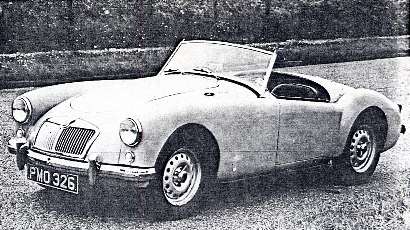
Published
The Autocar,
18 July 1958
The radiator grill bears the well-known M.G. octagon motif. On each side of the bonnet are vents to allow hot air to escape from the engine compartment. Direction indicators are combined with the side lights.
 M.G. Twin Cam MGA
M.G. Twin Cam MGA
OPEN TWO-SEATER
 By producing a high performance model to partner the successful MGA two-seater, the M.G. Car Company LTD., has filled a gap which has been evident to overseas and competition minded motorists; the new 1,500 c.c. twin overhead camshaft engine will enable the car to compete on equal terms in the 1,300-1,600 c.c. class with Continental built cars. As described in preceding pages, this engine is a developement of the special power unit used in the record-breaking M.G. EX 181. By producing a high performance model to partner the successful MGA two-seater, the M.G. Car Company LTD., has filled a gap which has been evident to overseas and competition minded motorists; the new 1,500 c.c. twin overhead camshaft engine will enable the car to compete on equal terms in the 1,300-1,600 c.c. class with Continental built cars. As described in preceding pages, this engine is a developement of the special power unit used in the record-breaking M.G. EX 181.
 The new model also has Dunlop 10-3/4in disk brakes, centre-lock steel wheels and Road Speed tyres, which are not fitted to the standard MGA. The road test car was an open model equipped with hood and side screens and all optionally extra equipment. A coupe version of the car is available. The new model also has Dunlop 10-3/4in disk brakes, centre-lock steel wheels and Road Speed tyres, which are not fitted to the standard MGA. The road test car was an open model equipped with hood and side screens and all optionally extra equipment. A coupe version of the car is available.
 Powered by the twin carburettor version of the 1-1/2 litre B series engine, the standard MGA coupe is capable of slightly more than 100 m.p.h.; the new 1,600 c.c. unit gives teh open car, with hood and side screens in position, a maximum of 114 m.p.h. It is faster than the 1-1/2 litre car by 1.7sec to 60 m.p.h., and by 15sec to 90 m.p.h. Powered by the twin carburettor version of the 1-1/2 litre B series engine, the standard MGA coupe is capable of slightly more than 100 m.p.h.; the new 1,600 c.c. unit gives teh open car, with hood and side screens in position, a maximum of 114 m.p.h. It is faster than the 1-1/2 litre car by 1.7sec to 60 m.p.h., and by 15sec to 90 m.p.h.
 The engine starts easily and quickly reaches working temperture. It revs freely, and the limit marking on the tachometer is 7,000 r.p.m.; it was taken up to this limit repetedly during the test. The engine starts easily and quickly reaches working temperture. It revs freely, and the limit marking on the tachometer is 7,000 r.p.m.; it was taken up to this limit repetedly during the test.
 Engine vibration was noticed at 2,500 and 5,500 r.p.m.; at maximum speed in top gear the tachometer reading was 6,500 r.p.m., and this was held for approximately 5 miles on a level stretch of autoroute. Engine vibration was noticed at 2,500 and 5,500 r.p.m.; at maximum speed in top gear the tachometer reading was 6,500 r.p.m., and this was held for approximately 5 miles on a level stretch of autoroute.
 Power builds up noticeably after the engine tops 3,500 r.p.m.; by the time 4,000 r.p.m. is reached it really takes hold and the little car begins to show its potential performance. In first gear it gets very quickly to 30 m.p.h., and a fast change to second gear is needed to avoid exceeding the rev. limit. The comfortable minimum speed in top is 18-20 m.p.h., and in traffic, second and third gears are most used. In open road cruising, 80-90 m.p.h. can be held indefinitely, with plenty in hand for use when required. The car was happy at 100 m.p.h. for long stretches on Continental roads, although to maintain high engine speeds has a marked effect on the fuel consumption, of course, and above 90 mph the driver has the feeling that the engine is working much harder. Power builds up noticeably after the engine tops 3,500 r.p.m.; by the time 4,000 r.p.m. is reached it really takes hold and the little car begins to show its potential performance. In first gear it gets very quickly to 30 m.p.h., and a fast change to second gear is needed to avoid exceeding the rev. limit. The comfortable minimum speed in top is 18-20 m.p.h., and in traffic, second and third gears are most used. In open road cruising, 80-90 m.p.h. can be held indefinitely, with plenty in hand for use when required. The car was happy at 100 m.p.h. for long stretches on Continental roads, although to maintain high engine speeds has a marked effect on the fuel consumption, of course, and above 90 mph the driver has the feeling that the engine is working much harder.
 There is a constant, rather obtrusive background of mechanical noise; most of this can be traced to the valve gear, particularly the tappets, which have a recommended clearance of .018in, but there is also a "ring" associated with the first stage of the timing gears. Nor can it be said that the engine is smooth or silky. Exhaust-wise, the car is not objectionable, and it can be driven through city traffic without attracting undue attention. This car had a loose silencer baffle. Carburettor intake noise is not noticeable, although only small flame-trap type air cleaners are fitted. There is a constant, rather obtrusive background of mechanical noise; most of this can be traced to the valve gear, particularly the tappets, which have a recommended clearance of .018in, but there is also a "ring" associated with the first stage of the timing gears. Nor can it be said that the engine is smooth or silky. Exhaust-wise, the car is not objectionable, and it can be driven through city traffic without attracting undue attention. This car had a loose silencer baffle. Carburettor intake noise is not noticeable, although only small flame-trap type air cleaners are fitted.
 From the performance and maintenance angles, the MGA has an enthusiast's engine. Many of the ancilliary units are not easy to reach, as the underbonnet space is filled by the engine itsellf. The distributor is located below a camshaft housing (it became covered in oil during the test), and the coil is tucked away under the heater trunking. The oil level dipstick would be easier to replace if its containing tube were a little longer. An oil cooler, which is an optional extra, was mounted in frot of the radiator, but no oil temperature gauge was supplied. From the performance and maintenance angles, the MGA has an enthusiast's engine. Many of the ancilliary units are not easy to reach, as the underbonnet space is filled by the engine itsellf. The distributor is located below a camshaft housing (it became covered in oil during the test), and the coil is tucked away under the heater trunking. The oil level dipstick would be easier to replace if its containing tube were a little longer. An oil cooler, which is an optional extra, was mounted in frot of the radiator, but no oil temperature gauge was supplied.
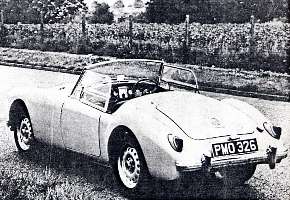 |
|
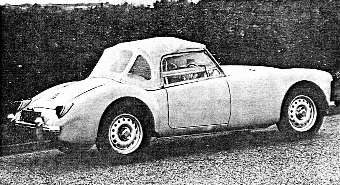 |
When the side curtains alone are used, the crew can enjoy fresh air motoring with some measure of protection from draughts. The Twin Cam insignia appears beneath the motif on the tail panel.
|
|
The hood and side curtains are a snug fit and follow closely the coutours of the body. There is no exterior door handle. Three large windows at the back of the hood are made of flexible Vybak. Bumper over-riders are standard.
|
 All maximum speed and accelleration tests were carried out with 100 octane petrol. With this, and Belgium premium petrol (89 research octane rating), the engine tended to "run on" after being switched off. It also used a considerable amount of oil; five pints were added to the simp during one journey of 800 miles, and an overall oil consumption figure of 1,020 m.p.g. was recorded--approximately one quart of oil each time the petrol tank (capacity 10 gallons) was refilled. All maximum speed and accelleration tests were carried out with 100 octane petrol. With this, and Belgium premium petrol (89 research octane rating), the engine tended to "run on" after being switched off. It also used a considerable amount of oil; five pints were added to the simp during one journey of 800 miles, and an overall oil consumption figure of 1,020 m.p.g. was recorded--approximately one quart of oil each time the petrol tank (capacity 10 gallons) was refilled.
 Once accustomed to the controls, an experienced driver can get off the mark with very little wheel spin, but it was felt that more suitable gearbox ratios would give an even more sparkling getaway, without losing the benefit of easy fast cruising--there is a very noticeable interval between first and second, and between second and third. An owner using the car for circuit racing would, no doubt, prefer a gearbox with closer ratios. A 4.55 to 1 axle ratio can be fitted in place of the standard 4.30 to 1 ratio at an extra cost of L10 2s 6d. Once accustomed to the controls, an experienced driver can get off the mark with very little wheel spin, but it was felt that more suitable gearbox ratios would give an even more sparkling getaway, without losing the benefit of easy fast cruising--there is a very noticeable interval between first and second, and between second and third. An owner using the car for circuit racing would, no doubt, prefer a gearbox with closer ratios. A 4.55 to 1 axle ratio can be fitted in place of the standard 4.30 to 1 ratio at an extra cost of L10 2s 6d.
 Apart from occasional difficulty in selecting first gear when the car is stationary, the gearbox is generally pleasant to use. The short, remote control lever has precise movements between the ratios, and very fast changes can be made. One notices a slight difficulty--not uncommon in B series gearboxes--in getting through the gate transversely, particularly when the gearbox is hot. This sometimes makes difficult the change from third to second, and there is a risk that the lever may overshoot into the reverse quadrant. The top of the lever is close to the steering wheel when the latter is set near the facia; it is also well placed in relation to the driver's seat. There was no vibration from the transmission, and the axle was silent. Apart from occasional difficulty in selecting first gear when the car is stationary, the gearbox is generally pleasant to use. The short, remote control lever has precise movements between the ratios, and very fast changes can be made. One notices a slight difficulty--not uncommon in B series gearboxes--in getting through the gate transversely, particularly when the gearbox is hot. This sometimes makes difficult the change from third to second, and there is a risk that the lever may overshoot into the reverse quadrant. The top of the lever is close to the steering wheel when the latter is set near the facia; it is also well placed in relation to the driver's seat. There was no vibration from the transmission, and the axle was silent.
 Free from slip during full bore gear changes, the clutch transmitted the engine power without judder under all conditions. Some adjustment was found necessary to take up pedal movement, but once attended to the need did not recur. Positioning of the pedals is good, although to clear the clutch pedal, the left foot has to be placed beneath it rather than to the left. The accellerator, which is connected to the throttle by a cable, works smoothly, and delicate, progressive control can be achieved. Free from slip during full bore gear changes, the clutch transmitted the engine power without judder under all conditions. Some adjustment was found necessary to take up pedal movement, but once attended to the need did not recur. Positioning of the pedals is good, although to clear the clutch pedal, the left foot has to be placed beneath it rather than to the left. The accellerator, which is connected to the throttle by a cable, works smoothly, and delicate, progressive control can be achieved.
 Among the most delightful features of the MGA are its road holding and cornering. The manufacturers' well known motto--Safety Fast--is particularly pertinent to this new model. Changes in road surface have little effect on the manner in which the car sits firmly on the road, and its behavior on a streaming wet road is equally good, although the tail will swing slightly if the throttle is opened suddenly when cornering. Power can be used judiciously to help the car round a corner, in fact progress on a winding road is all the better if this technique is applied. Among the most delightful features of the MGA are its road holding and cornering. The manufacturers' well known motto--Safety Fast--is particularly pertinent to this new model. Changes in road surface have little effect on the manner in which the car sits firmly on the road, and its behavior on a streaming wet road is equally good, although the tail will swing slightly if the throttle is opened suddenly when cornering. Power can be used judiciously to help the car round a corner, in fact progress on a winding road is all the better if this technique is applied.
 There is a strong self-centering of the steering, and there is no lost motion to impair its accuracy; from lock to lock requires only 2-1/4 turns of the wheel, and although the turning circle is greater by 4ft 6in than that of the 1-1/2 litre engine car, the Twin Cam model can be manoeuvered easily in narrow streets. There is a strong self-centering of the steering, and there is no lost motion to impair its accuracy; from lock to lock requires only 2-1/4 turns of the wheel, and although the turning circle is greater by 4ft 6in than that of the 1-1/2 litre engine car, the Twin Cam model can be manoeuvered easily in narrow streets.
 A slight heaviness in the steering was noticed with the tyres inflated to the normal recommended 18 lb front and 20 lb rear; when pressures were raised by 4 lb sq in, this heaviness disappeared and the ride was not uncomfortable. A slight heaviness in the steering was noticed with the tyres inflated to the normal recommended 18 lb front and 20 lb rear; when pressures were raised by 4 lb sq in, this heaviness disappeared and the ride was not uncomfortable.
 With full load, or with the driver only in the car, there is a satisfactory firmness about the suspension, which reaches and excellent compromise in a car which may be called upon to take the owner to work during the week, and yet be driven in races at the weekend. Stability is first class and there is no heeling-over on corners, although brisk progress is marked by excessive tyre squeal; the latest pattern Road Speed tyres were not fitted to the test car. With full load, or with the driver only in the car, there is a satisfactory firmness about the suspension, which reaches and excellent compromise in a car which may be called upon to take the owner to work during the week, and yet be driven in races at the weekend. Stability is first class and there is no heeling-over on corners, although brisk progress is marked by excessive tyre squeal; the latest pattern Road Speed tyres were not fitted to the test car.
 The driving position is well suited to most drivers, but a person of small stature would be happier with a higher seat cushion. The steering wheel can be set close to the facia, by a lock-nut and bolt fitting; in this position of adjustment the driver has fingertip control of the horn button and indicator switch. The thin-rimmed wheel is set to an ideal angle for control, being almost vertical; it does not obscure the instruments. The driving position is well suited to most drivers, but a person of small stature would be happier with a higher seat cushion. The steering wheel can be set close to the facia, by a lock-nut and bolt fitting; in this position of adjustment the driver has fingertip control of the horn button and indicator switch. The thin-rimmed wheel is set to an ideal angle for control, being almost vertical; it does not obscure the instruments.
 Fitted to the test car were the competition-type seats, which have a padded roll around the edge of the back rest, and long cushion; they proved most comfortable and provided firm support at a good angle. Driver and passenger are well held when cornering fast, and long distances can be covered without fatigue. The proximity of the engine and gearbox can bring about an uncomfortably high temerature around the legs and feet; it is probably that owners in hot climates will call for spare fresh air ventilators. On the other hand, the warmth would be appreciated in winter conditions. Fitted to the test car were the competition-type seats, which have a padded roll around the edge of the back rest, and long cushion; they proved most comfortable and provided firm support at a good angle. Driver and passenger are well held when cornering fast, and long distances can be covered without fatigue. The proximity of the engine and gearbox can bring about an uncomfortably high temerature around the legs and feet; it is probably that owners in hot climates will call for spare fresh air ventilators. On the other hand, the warmth would be appreciated in winter conditions.
 The parking brake is controlled by a fly-off pattern lever, in which the button is pressed to lock the brake on. The lever is placed between the transmission cover and the driving seat, and the hand falls readily on it. The parking brake is controlled by a fly-off pattern lever, in which the button is pressed to lock the brake on. The lever is placed between the transmission cover and the driving seat, and the hand falls readily on it.
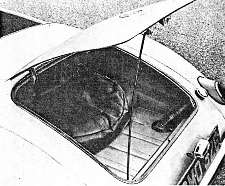

|
A cover encloses the spare tire on top which is strapped the tool kit. The petrol filler has a quick release cap. |
|
The polished aluminum covers of the camshaft housings dominate the under-bonnet view. |
|
 All the advantages which this car affords for fast motoring would be wasted if the braking system was not up to the same standards. It is becoming increasingly the practice for 100 m.p.h. cars, whether they are large saloons or agile two-seaters, to be fitted with disc brakes. The Dunlop 10-3/4in diameter discs fitteed to the Twin Cam MGA are adequate for all they are called upon to do in wet or dry. The pedal has a good feel to it, being neither spongy or hard, though loads are rather high in normal traffic stops; this is normal with discs, which have no self-servo effect, and is noticeable when there is no external servo, as in the case of the MGA. Maximum braking brought the car to a standstill all square, and the brakes could be applied hard when the car was being driven fast on wet roads. There was no noticeable increse in pedal travel after 800 miles of fast driving. The font discs did show signs of scoring, which has not been noticed on other cars. All the advantages which this car affords for fast motoring would be wasted if the braking system was not up to the same standards. It is becoming increasingly the practice for 100 m.p.h. cars, whether they are large saloons or agile two-seaters, to be fitted with disc brakes. The Dunlop 10-3/4in diameter discs fitteed to the Twin Cam MGA are adequate for all they are called upon to do in wet or dry. The pedal has a good feel to it, being neither spongy or hard, though loads are rather high in normal traffic stops; this is normal with discs, which have no self-servo effect, and is noticeable when there is no external servo, as in the case of the MGA. Maximum braking brought the car to a standstill all square, and the brakes could be applied hard when the car was being driven fast on wet roads. There was no noticeable increse in pedal travel after 800 miles of fast driving. The font discs did show signs of scoring, which has not been noticed on other cars.
 At night reasonable use can be made of the car's performance, although more powerful headlamps would be appreciated for speeds close to 100 m.p.h.; the dipped beam did not inconvenience oncoming traffic. The Twin Cam MGA is one of the cars which really do require a hand dipper switch. When driving on the open road at night, one needs two left feet to operte the clutch and the foot dipper, for the driver always seems to need to change gear and to alter the light setting at the same moment. The positioning of the pedal and switch are such that the changeover cannot be made on the instant. At night reasonable use can be made of the car's performance, although more powerful headlamps would be appreciated for speeds close to 100 m.p.h.; the dipped beam did not inconvenience oncoming traffic. The Twin Cam MGA is one of the cars which really do require a hand dipper switch. When driving on the open road at night, one needs two left feet to operte the clutch and the foot dipper, for the driver always seems to need to change gear and to alter the light setting at the same moment. The positioning of the pedal and switch are such that the changeover cannot be made on the instant.
 Facia instruments are well lit, and the switch is fitted with a rheostat. There is a small map light with a separate switch on the left side of the facia. Self-parking wipers are fitted, and although they are powerful and silent they are up against an unusual handicap--in heavy rain, water is blown off the bonnet onto the screen, and the wipers have difficulty in clearing it. An owner could perhaps prevent this by fitting a shallow Perspex deflector across the bonnet to deflect the air stream up and over the screen. Facia instruments are well lit, and the switch is fitted with a rheostat. There is a small map light with a separate switch on the left side of the facia. Self-parking wipers are fitted, and although they are powerful and silent they are up against an unusual handicap--in heavy rain, water is blown off the bonnet onto the screen, and the wipers have difficulty in clearing it. An owner could perhaps prevent this by fitting a shallow Perspex deflector across the bonnet to deflect the air stream up and over the screen.
 With the hood and side curtians erected, the car proved weatherproof except at speeds over 90 m.p.h., when the wind pressure tended to lift the hood above the middle of the windscreen; rain found its way in there, and also through the scuttle on the passenger's legs. Although there were gaps between the windscreen frame and the side screens, rain did not penetrate here. The hood is comparatively simple to erect and can be folded away neatly behind the seat backrests. A plastic bag, secured to the bodywork behind the seats, provided stowage for the side curtains. With the hood and side curtians erected, the car proved weatherproof except at speeds over 90 m.p.h., when the wind pressure tended to lift the hood above the middle of the windscreen; rain found its way in there, and also through the scuttle on the passenger's legs. Although there were gaps between the windscreen frame and the side screens, rain did not penetrate here. The hood is comparatively simple to erect and can be folded away neatly behind the seat backrests. A plastic bag, secured to the bodywork behind the seats, provided stowage for the side curtains.
 With the hood and side curtains erected, a tall driver has no difficulty getting into or out of the car, and there is ample headroom. In this condition, the occupants find the interior rather warm, and it was not possible to obtain a flow of cool air through the vent above the gearbox cover. A heater--part of the extra equipment--proved amply efficient in the moderate temperatures encountered during the test. With the hood and side curtains erected, a tall driver has no difficulty getting into or out of the car, and there is ample headroom. In this condition, the occupants find the interior rather warm, and it was not possible to obtain a flow of cool air through the vent above the gearbox cover. A heater--part of the extra equipment--proved amply efficient in the moderate temperatures encountered during the test.
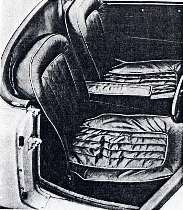
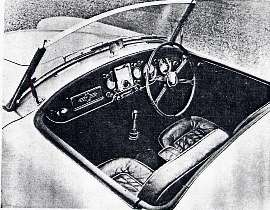
|
Competition seats, an optional extra, are contoured to give extra support in cornering, and under the thighs. |
|
This is the functional facia, with neat, easy to read dials. The main switches come quickly to hand. The steering wheel is shown in its nearest adjustment to the facia. The plated support on the left of the windscreen forms a useful grab handle for the passenger. |
|
 Accomodation for maps and small articles is provided by a deep pocket in each door, but as the doors cannot be locked, it is not adviseable to store valuables in these pockets if the car is left unattended. Only the Twin Cam models and the 1-1/2 litre coupe are supplied with a leather facia. A large portion of the luggage compartment is occupied by the spare tyre and tool kit, and it is not easy to find room for a large suitcase, but a number of small bags and boxes can be stowed away. If coats and soft traveling bags are fitted in carefully, more can be carried than at first appears likely. Accomodation for maps and small articles is provided by a deep pocket in each door, but as the doors cannot be locked, it is not adviseable to store valuables in these pockets if the car is left unattended. Only the Twin Cam models and the 1-1/2 litre coupe are supplied with a leather facia. A large portion of the luggage compartment is occupied by the spare tyre and tool kit, and it is not easy to find room for a large suitcase, but a number of small bags and boxes can be stowed away. If coats and soft traveling bags are fitted in carefully, more can be carried than at first appears likely.
 The tool kit includes a starting handle and, surprise, an old fashion. screw type lifting jack. Two six volt batteries are located just forward of the rear axle; to service them the spare wheel and a panel in the floor behind the seats must be removed. The high pressure electric fuel pump is close to the battery on the right side of the frame. Nine lubrication points require grease gun attention every 1,000 miles. The tool kit includes a starting handle and, surprise, an old fashion. screw type lifting jack. Two six volt batteries are located just forward of the rear axle; to service them the spare wheel and a panel in the floor behind the seats must be removed. The high pressure electric fuel pump is close to the battery on the right side of the frame. Nine lubrication points require grease gun attention every 1,000 miles.
 In the road test of the 1-1/2 litre MGA coupe it was stated in summary that the car was capable of holding its own against more powerful vehicles; this applied even more markedly to the 1,600 c.c. Twin Cam model. The extra performance is matched by the road holding, steering and brakes, and this car maintains the M.G. tradition of good looks coupled with a very fine performance. In the road test of the 1-1/2 litre MGA coupe it was stated in summary that the car was capable of holding its own against more powerful vehicles; this applied even more markedly to the 1,600 c.c. Twin Cam model. The extra performance is matched by the road holding, steering and brakes, and this car maintains the M.G. tradition of good looks coupled with a very fine performance.
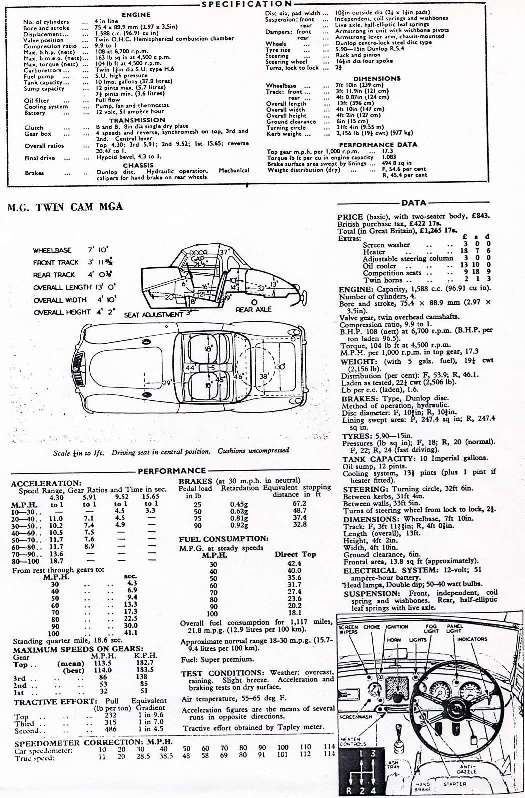
CLICK FOR LARGER IMAGE - (288KB)
|
